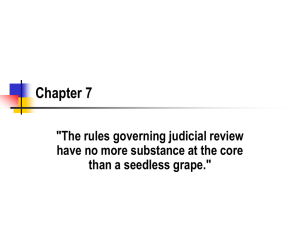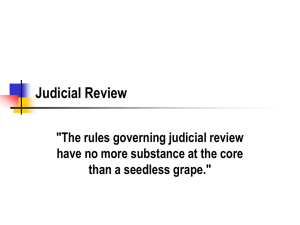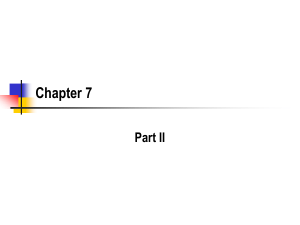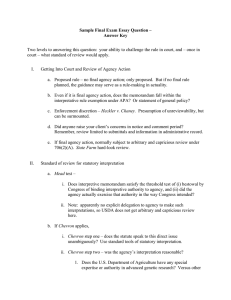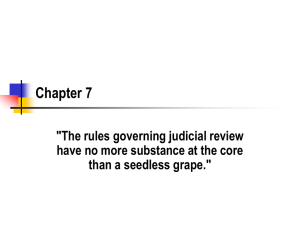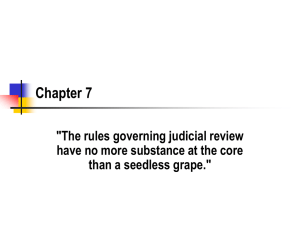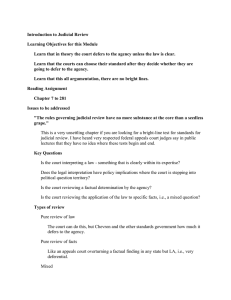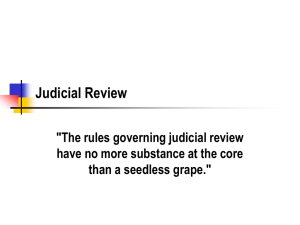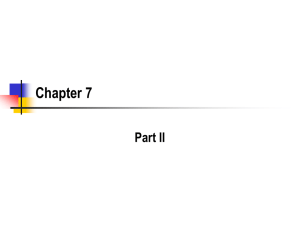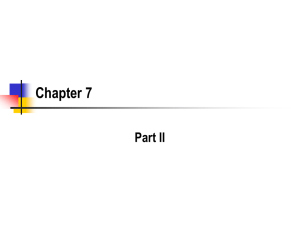Judicial Review
advertisement
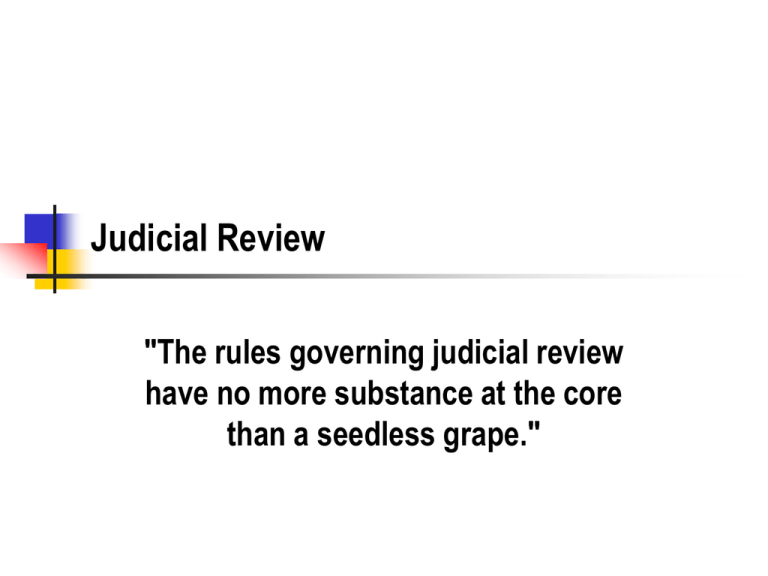
Judicial Review "The rules governing judicial review have no more substance at the core than a seedless grape." Key Questions When can the court substitute its judgment for the agency's judgment? How much does the court defer to the agency's decision? Why is some level of deference to the agency critical to agency function? 2 Review of Rulemaking and Formal APA Proceedings APA § 706. Scope of review http://biotech.law.lsu.edu/Courses/study_aids/adla w/706.htm 3 Questions of Law What are the different types of questions of law? Why are these essentially facial challenges? Is the agency more expert in law than the court? 4 Deference - National Labor Relations Board v. Hearst Publications, Inc., 322 U.S. 111 (1944) Undoubtedly questions of statutory interpretation, especially when arising in the first instance in judicial proceedings, are for the courts to resolve, giving appropriate weight to the judgment of those whose special duty is to administer the questioned statute. But where the question is one of specific application of a broad statutory term in a proceeding in which the agency administering the statute must determine it initially, the reviewing court's function is limited. . . . [T]he Board's determination that specified persons are 'employees' under this Act is to be accepted if it has 'warrant in the record' and a reasonable basis in law. 5 Persuasion - Skidmore v. Swift & Co., 323 U.S. 134, 140 (1944) We consider that the rulings, interpretations and opinions of the Administrator under this Act, while not controlling upon the courts by reason of their authority, do constitute a body of experience and informed judgment to which courts and litigants may properly resort for guidance. The weight of such a judgment in a particular case will depend upon the thoroughness evident in its consideration, the validity of its reasoning, its consistency with earlier and later pronouncements, and all those factors which give it power to persuade, if lacking power to control. 6 Chevron Clean Air Act Case EPA wanted to consider all of the sources of pollution within a given chemical plant as one source - the bubble model What would be the advantage of this for EPA? Why would environmentalists oppose it? The statute did not give clear guidance What should the court do? 7 Chevron Step One If the statute speaks clearly to the point, then you have to follow the statute This assumes that the statute is constitutional 8 Chevron Step Two If the statute is silent or ambiguous a court may not substitute its own construction of a statutory provision for a reasonable interpretation made by the administrator of an agency 9 What does it Mean to Be Silent or Ambiguous? Do you just look at the statute itself? Scalia, usually. Do you include legislative intent? Breyer, usually. 10 Political Control of Agencies How does Chevron deference fit with the political control of agencies? Is this a liberal/conservative view? 11 Miller v. AT&T Corp., 250 F.3d 820 (4th Cir. 2001) The Family and Medical Leave Act (FMLA) does not define medical treatment The agency finds that visits to the doctor that do not require specific treatment are covered by the act What is the ambiguity? Did the court accept the agency interpretation? Why does this decision make practical sense? 12 What Agency do you Defer to? While many agencies may have some responsibilities under a given law, the court will only defer to the agency with the primary responsibility for administering the law Why would it be a problem to defer to more than one agency for the same statutory provisions? What if the question involves the jurisdiction of the agency? No clear answer 13 Food and Drug Administration v. Brown & Williamson Tobacco Corp., 529 U.S. 120 (2000) We will discussion this case separately. 14 Example - Court/Agency Conflicts in Interpretation Portland wants to regulate broadband providers Industry says they are telecommunications providers, thus not subject to local regulation Appeals Court agrees FCC promulgates a rule defining broadband providers as information services, which can be regulated Did the Appeals Court settle this issue? What if the Portland case had been decided by the United States Supreme Court? 15 Christensen v. Harris County, 529 U.S. 576 (2000) What did the court rule? “Here . . . we confront an interpretation contained in an opinion letter, not one arrived at after, for example, a formal adjudication or notice-and-comment rulemaking. Interpretations such as those in opinion letters--like interpretations contained in policy statements, agency manuals, and enforcement guidelines, all of which lack the force of law--do not warrant Chevron-style deference.” Why is this consistent with our definition of a guidance document? 16 When does Chevron Apply? - United States v. Mead, 533 U.S. 218 (2001) Chevron was a notice and comment rule Why does the notice and comment process better assure that an agency legal interpretation is sound? Mead is letter ruling on the classification of a product for tariff purposes No notice and comment Can be changed at a latter date without notice and comment Should this letter ruling get Chevron deference? 17 The Mead Test administrative implementation of a particular statutory provision qualifies for Chevron deference when it appears that Congress delegated authority to the agency generally to make rules carrying the force of law, and that the agency interpretation claiming deference was promulgated in the exercise of that authority. What would you look for to decide if Mead applied? 18 Back to Persuasiveness? - Barnhart v. Walton, 535 U.S. 212 (2002) The importance of interpretation to agency policy; The period that the agency has held the view; The legal expertise of the agency; The complexity of the problem; These modify Mead What can the agency due to strengthen its case for deference? 19 Public Citizen v. U.S. Dept. of Health and Human Services, 332 F.3d 654 (D.C. Cir. 2003) Is the Medicare Manual a notice and comment regulation? If not, what is it? Does this look more like Mead or Chevron? Did the court find that the manual was a regulation with the force of law? How can the Medicare Manual be binding on providers if it does not have the force of law? 20 ABA Adlaw Conference - Justice Garland, 2nd Cir, on Chevron: If you have an ambiguous statute, and need Chevron deference, do not say that the interpretation is clear and there is no other way to construe the law. Say it is ambiguous and you are making a reasonable interpretation based on your knowledge of the statute and the regulatory circumstances. 21 Interpretation of Agency Rules Should interpretation of rules and statutes be the same standard? Are they? How are interpretations of rules treated differently? What perverse incentives does this give the agency? 22
